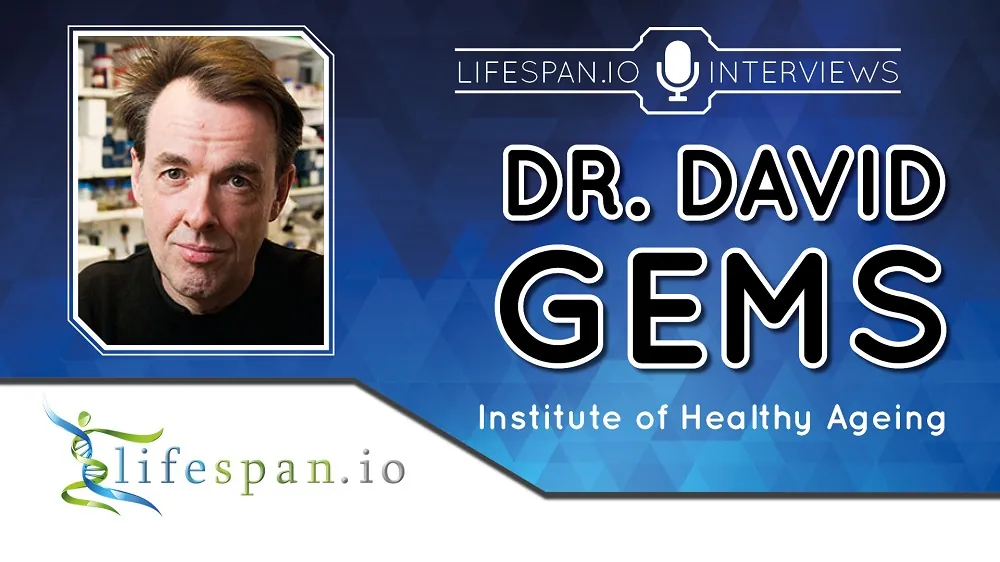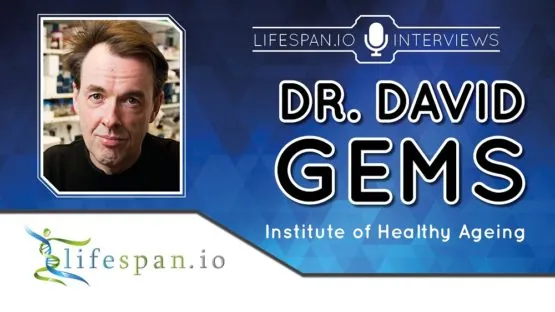Elena Milova was at the Interventions to extend healthspan and lifespan 2018 conference in Kazan. This is an important conference in the aging research field, and it includes a variety of leading experts giving talks about their research. During the event, Elena had the opportunity to talk with professor David Gems about his work and his views on aging.
Professor Gems is a British geneticist and biogerontologist. He is Professor of Biology of Ageing at University College London, where he is also Deputy Director of the Institute of Healthy Ageing. His work focuses on understanding aging through the genetics of the nematode worm C. elegans.
How do you think we age; are we programmed to die, do we wear out, or is the truth a mixture of both?
Senescence appears to be the result of a combination of different types of etiology, including the action of wild-type (i.e. normal, non-mutant) genes, and various sorts of damage (including mechanical damage or mechanical senescence, which involves a type of wearing-out process). Which is more important likely depends on the species and on the pathology. For example, some pathologies in C. elegans appear to be the result of futile run-on of biological programs. However, in most types of mammalian cancer (which is largely a disease of aging), damage to DNA clearly plays an important role.
Why do you think aging exists at all?
The answer to this is provided by the evolutionary theory of aging. Aging occurs because the strength of natural selection reduces with increasing age after the onset of reproduction. Evolution selects gene variants that maximize fitness in early life, even though they may promote senescent pathology later. By this view, senescence is a form of complex genetic disease caused by wild-type genes.
What do you think about the role of epigenetic changes and how they regulate gene expression; are they one of the drivers of aging or a consequence?
There has been a lot of interesting work on this during the last decade. Manipulating epigenetic changes can affect lifespan, and epigenetic alterations such as DNA methylation are excellent biomarkers of biological age. Yet it seems far from clear that such changes somehow represent a primary cause of aging.
Do you have a favorite aging hypothesis, and why?
Yes, I do. Currently, I believe that senescence is not a disease syndrome with a single etiology; rather, it is a set of disease syndromes and stand-alone diseases with multiple etiologies. I believe that the predominant type of cause of aging is wild-type gene action in later life, as predicted by Williams’ antagonistic pleiotropy theory, but that stochastic damage also plays a role, depending upon the species, for example, DNA damage and mechanical damage (mechanical senescence).
Your research focuses on C. elegans worms. How relevant to human aging is what we learn from these worms?
The precise answer to this question will only become clear when we achieve a better understanding of aging in C. elegans. Some aspects of the biology of aging in C. elegans are highly relevant to human aging. For example, C. elegans lifespan can be greatly extended by inhibition of the insulin/IGF-1 and mTOR signaling pathways, which were subsequently shown to influence the aging rate in humans. It is my belief that a full understanding of the proximate mechanisms of aging in C. elegans, downstream of and regulated by the signaling pathways that affect aging, will contribute to a broad understanding of the nature of the aging process, just as gene function was first understood by studying simple organisms like bacteria and bacterial viruses. Critically, in a simple animal like C. elegans, we have a good chance of achieving a full understanding of aging. In this respect, the worm has yet to give up some of its greatest treasures.
Do you agree with the statement that we have all that is necessary to cure aging in the worm, given the numerous interventions that increase their lifespan; could we technically cure aging in worms with the technology we have now?
The statement is certainly false. Some interventions cause large increases in lifespan in C. elegans, in terms of fold change in lifespan. However, in these cases, the animals still die of senescence.
Can aging, or rather the various processes that constitute aging, be considered a disease or perhaps a co-morbid syndrome?
Asking whether aging is a disease is confusing since the word has at least 3 distinct meanings: calendar aging, adult age-related changes of any kind (good, bad or neutral), and senescence. Unsurprisingly, therefore, discussions of this question are often confused.
Senescence, by definition, is a process of deterioration, so, arguably, it is a disease or, to be more precise, a collection of diseases and disease syndromes (since it clearly has no single, simple cause).
The current approach of treating age-related diseases is essentially the same as we treat infectious diseases: we wait for the diagnosis and then treat the symptoms. This approach is one of diminishing returns. What do you think of the idea to treat the various aging processes driving these diseases in order to prevent or reverse a whole slew of them at once?
Like most people working on the biology of aging, I believe so. This can be achieved in the laboratory in short-lived animals, such as mice. What is currently lacking is a demonstration that this can be achieved in human beings.
It has been projected that if you eliminated all cancers, it would only add about 3 or 4 years of lifespan, as people would just die of another age-related disease. Do you think a preventive approach that targets the aging processes might yield more impressive gains in terms of healthspan and lifespan?
Like most people working on the biology of aging, I believe so.
Do you take any personal health and longevity measures yourself?
I don’t take any sort of anti-aging drugs or supplements. However, if there were any with proven efficacy and demonstrated safety, I would gladly take them.
What is the biggest bottleneck to progress in aging research, in your view?
There are many, but I find it hard to say which is the biggest. To name a few…
- Lack of sufficient research funding (obvious, but true).
- The entrenched configuration of the medical research establishment that leads to diseases of aging being studied separately (in silos).
- Lack of public awareness of the potential of current progress in biogerontology, due to it being drowned out by bogus information generated by commercial anti-aging medicine peddlers, swindlers of the elderly, and self-publicizing mountebanks.
- The drain of time and resources engendered by the need to publish in high-impact journals due to the use of journal impact factors as performance measures
- As often happens in science, a lack of imagination and of encouragement and support for original approaches.
We would like to thank Professor Gems for taking the time to do this interview with us and sharing his insights.




